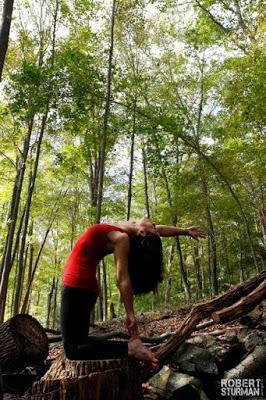
Judi Friedman, Age 52, photographed by Robert Sturman
Q: Nina asked me what I thought about the recent conversation that she and Ram had via email (see Are Backbends Stimulating or Relaxing?) and I couldn’t help but chime in! So here is what I, Baxter, have to say about the effect of more intense poses and practices on the response of the Autonomic Nervous System and therefore on vagal tone:A: Nina, I agree with your anecdotal observations as well as your theoretical ponderings (and on a few things, with Ram, too). And my reasons are multiple:
- Some students are going to be more challenged by advanced back bends and aerobic flow classes due to a) musculoskeletal issues that make backbends harder for their bodies to do, and b)aerobic fitness levels that are not equal to the intensity of the flow class they are taking. These situations are going to trigger the Sympathetic Nervous System (SNS) branch of the Autonomic Nervous System.
- All the other reasons Ram mentions could contribute to increased stress response in a person, thus triggering the Fight or Flight response of the SNS too. And, of course, I agree with his initial statement of the underlying goals of yoga.
- As you postulate, abnormal breathing patterns, such as restricted breath in backbends or the tendency to inhale and hold the breath momentarily when doing difficult or unfamiliar poses could also stimulate the SNS.
- I also agree that not all yoga practices are designed to quiet and calm the mind exclusively. As you rightly note, in the Hatha Yoga tradition, there is the idea of “firing the vessel,” as with pottery, to strengthen it and make it resilient under the challenges of the deeper levels of mental practices of yoga as one moves towards states like samadhi. So, at times, we want to stimulate the SNS, too, but not right before bedtime!
To which I’m adding: Nina, this is a good point. In the moment of practicing, practices like deep, challenging backbends and strong flow practices will likely trigger the Sympathetic branch of the nervous system. If this is a strong enough stimulation, it could be challenging to calm the system during the course of practice. Vickie Russell Bell has a good sequencing way of balancing things out in her evening classes where she provides adequate time to cool the nervous system down. This will ideally allow the practitioner to shift the nervous system to the Parasympathetic side of things, so the entire system can have a greater chance to quiet and calm both body and mind. A big challenge today is that many yoga classes don’t provide adequate cool-down time, often only leaving 4-5 minutes at the end of class for Savasana. This is not likely going to induce the Relaxation Response, which Herbert Benson, MD, noted comes on between 7-10 minutes.
And this is certainly not a black or white issue. There are some fit and flexible students who will remain relatively neurologically calm doing the proposed back bend and flow practices, and will likely wonder what all the fuss of over!
—Baxter
Subscribe to Yoga for Healthy Aging by Email ° Follow Yoga for Healthy Aging on Facebook ° Join this site with Google Friend Connect

